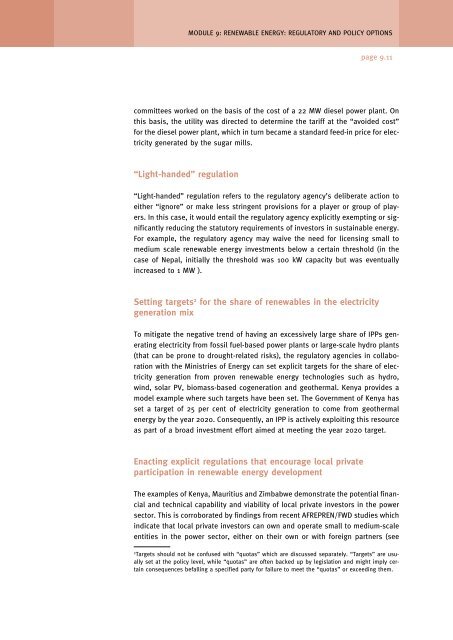Regulatory and policy options to encourage development of ...
Regulatory and policy options to encourage development of ...
Regulatory and policy options to encourage development of ...
- No tags were found...
Create successful ePaper yourself
Turn your PDF publications into a flip-book with our unique Google optimized e-Paper software.
MODULE 9: RENEWABLE ENERGY: REGULATORY AND POLICY OPTIONSpage 9.11committees worked on the basis <strong>of</strong> the cost <strong>of</strong> a 22 MW diesel power plant. Onthis basis, the utility was directed <strong>to</strong> determine the tariff at the “avoided cost”for the diesel power plant, which in turn became a st<strong>and</strong>ard feed-in price for electricitygenerated by the sugar mills.“Light-h<strong>and</strong>ed” regulation“Light-h<strong>and</strong>ed” regulation refers <strong>to</strong> the regula<strong>to</strong>ry agency’s deliberate action <strong>to</strong>either “ignore” or make less stringent provisions for a player or group <strong>of</strong> players.In this case, it would entail the regula<strong>to</strong>ry agency explicitly exempting or significantlyreducing the statu<strong>to</strong>ry requirements <strong>of</strong> inves<strong>to</strong>rs in sustainable energy.For example, the regula<strong>to</strong>ry agency may waive the need for licensing small <strong>to</strong>medium scale renewable energy investments below a certain threshold (in thecase <strong>of</strong> Nepal, initially the threshold was 100 kW capacity but was eventuallyincreased <strong>to</strong> 1 MW ).Setting targets 2 for the share <strong>of</strong> renewables in the electricitygeneration mixTo mitigate the negative trend <strong>of</strong> having an excessively large share <strong>of</strong> IPPs generatingelectricity from fossil fuel-based power plants or large-scale hydro plants(that can be prone <strong>to</strong> drought-related risks), the regula<strong>to</strong>ry agencies in collaborationwith the Ministries <strong>of</strong> Energy can set explicit targets for the share <strong>of</strong> electricitygeneration from proven renewable energy technologies such as hydro,wind, solar PV, biomass-based cogeneration <strong>and</strong> geothermal. Kenya provides amodel example where such targets have been set. The Government <strong>of</strong> Kenya hasset a target <strong>of</strong> 25 per cent <strong>of</strong> electricity generation <strong>to</strong> come from geothermalenergy by the year 2020. Consequently, an IPP is actively exploiting this resourceas part <strong>of</strong> a broad investment effort aimed at meeting the year 2020 target.Enacting explicit regulations that <strong>encourage</strong> local privateparticipation in renewable energy <strong>development</strong>The examples <strong>of</strong> Kenya, Mauritius <strong>and</strong> Zimbabwe demonstrate the potential financial<strong>and</strong> technical capability <strong>and</strong> viability <strong>of</strong> local private inves<strong>to</strong>rs in the powersec<strong>to</strong>r. This is corroborated by findings from recent AFREPREN/FWD studies whichindicate that local private inves<strong>to</strong>rs can own <strong>and</strong> operate small <strong>to</strong> medium-scaleentities in the power sec<strong>to</strong>r, either on their own or with foreign partners (see2Targets should not be confused with “quotas” which are discussed separately. “Targets” are usuallyset at the <strong>policy</strong> level, while “quotas” are <strong>of</strong>ten backed up by legislation <strong>and</strong> might imply certainconsequences befalling a specified party for failure <strong>to</strong> meet the “quotas” or exceeding them.










